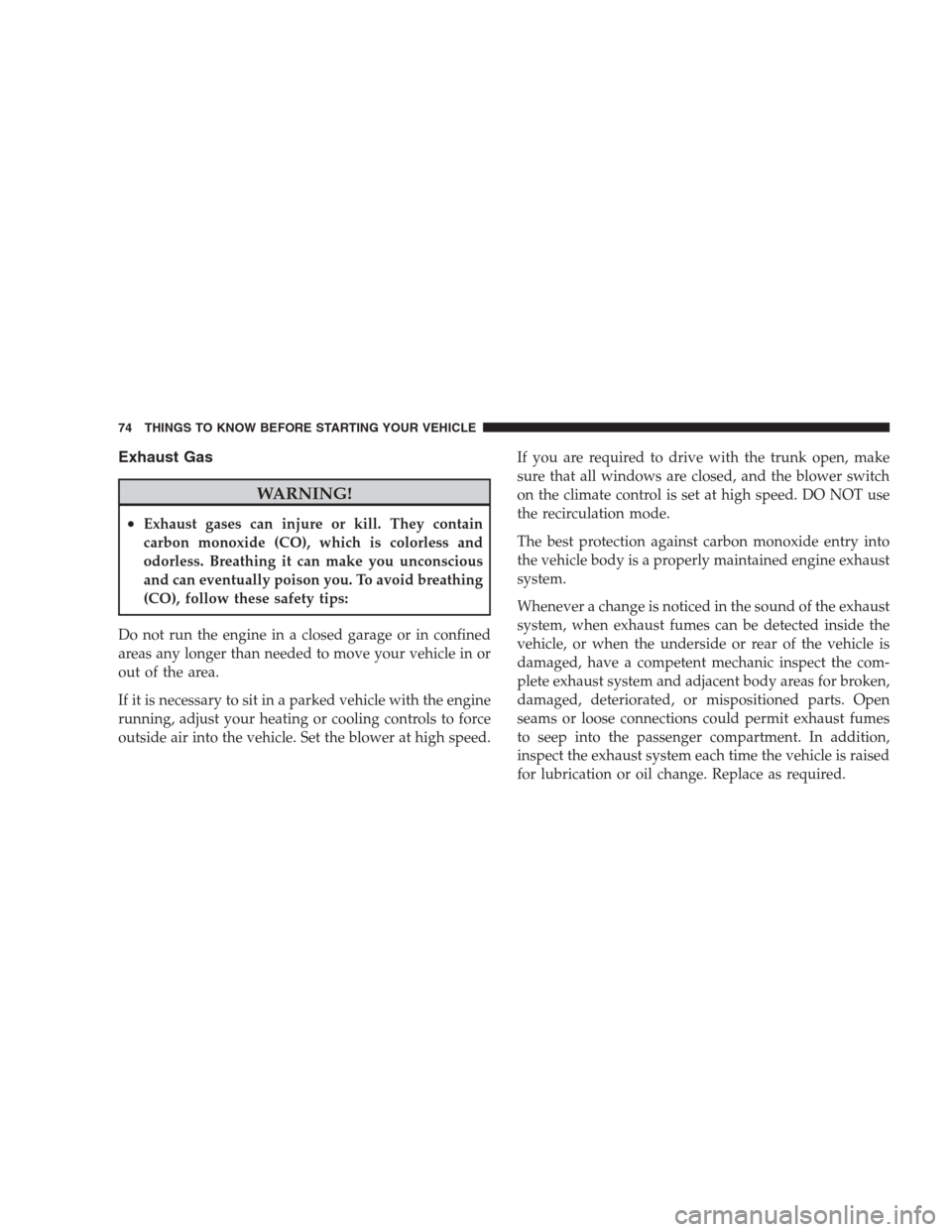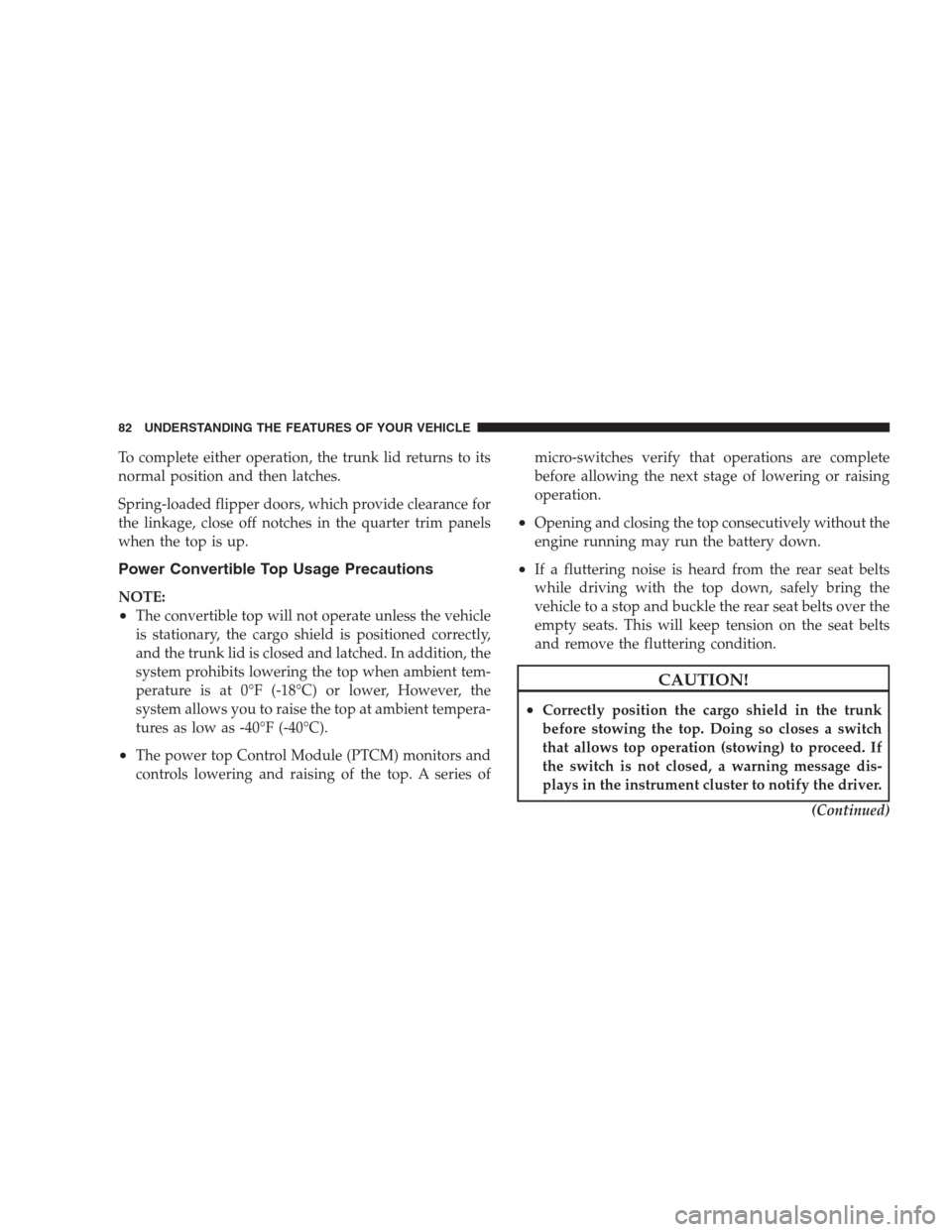Page 38 of 475

Wind Buffeting
Wind buffeting can be described as the perception of
pressure on the ears or a helicopter type sound in the
ears. Your vehicle may exhibit wind buffeting with one
window down in certain open or partially open posi-
tions. This is a normal occurrence and can be minimized.
If the buffeting occurs with one window open, then open
both windows together to minimize the buffeting.
TRUNK LOCK AND RELEASE
To unlatch the trunk lid from inside the vehicle, press and
release the TRUNK RELEASE Button located on the
instrument panel to the left of the steering wheel.
NOTE:The convertible top must be either closed and
latched or open and latched.The trunk release button on the
dash will be disabled if the vehicle
is locked by pressing the power
door lock switch or by pressing
the LOCK button on the Remote
Keyless Entry (RKE) transmitter.
The trunk release button will be
enabled when the vehicle is un-
locked by the RKE or if the key is
inserted into the ignition and
turned to ON or START.
NOTE:This provides a locked area in the vehicle even
if the convertible top is open.
To unlatch the trunk lid from outside the vehicle, press
and release the TRUNK RELEASE button on the RKE
transmitter two times.
Trunk Release
Button
36 THINGS TO KNOW BEFORE STARTING YOUR VEHICLE
Page 39 of 475
With the ignition ON, the word “deck” will display in the
odometer indicating the trunk is open. The odometer
display will reappear once the trunk is closed or if the
trip button is pressed.
With the key in the LOCK position or with the key out,
the word “deck” will display until the trunk is closed.
On vehicles equipped with the Electronic Vehicle Infor-
mation Center (EVIC), the words “Trunk Ajar” will
display.TRUNK SAFETY WARNING
WARNING!
Do not allow children to have access to the trunk,
either by climbing into the trunk from outside, or
through the inside of the vehicle. Always close the
trunk lid when your vehicle is unattended. Once in
the trunk, young children may not be able to escape,
even if they entered through the rear seat. If trapped
in the trunk, children can die from suffocation or
heat stroke.
THINGS TO KNOW BEFORE STARTING YOUR VEHICLE 37
2
Page 40 of 475
Trunk Internal Emergency Release
As a security measure, a Trunk Internal Emergency Release
lever is built into the trunk latching mechanism. In the event
of an individual being locked inside the trunk, the trunk can
be simply opened by pulling on the glow-in-the-dark handle
attached to the trunk latching mechanism.
OCCUPANT RESTRAINTS
Some of the most important safety features in your
vehicle are the restraint systems. The following safety
features are standard on your vehicle:
•Three point lap and shoulder belts for all seating
positions
•Pretensioning and load-limiting retractors for the front
seat belts
•Advanced dual-stage driver and front passenger air-
bags
•New active-vent front passenger airbags
•Knee bolsters/blockers for front seat occupants
•An energy absorbing steering column and steering
wheel
•Supplemental seat side (Thorax) airbagsTrunk Internal Emergency Release
38 THINGS TO KNOW BEFORE STARTING YOUR VEHICLE
Page 73 of 475
3. Push the tether strap and hook (B) through the access
port and down into the trunk.
NOTE:Route the tether strap to provide the most direct
path from the child seat to the anchor.4. Open the access cover (C) on the carpet covering the
back of the seat and attach the tether strap hook (D) to the
anchor.
5. Remove slack in the tether strap according to the child
restraint manufacturer’s instructions.
Child Tether Access Port Cover
Child Tether Anchor
THINGS TO KNOW BEFORE STARTING YOUR VEHICLE 71
2
Page 76 of 475

Exhaust Gas
WARNING!
•Exhaust gases can injure or kill. They contain
carbon monoxide (CO), which is colorless and
odorless. Breathing it can make you unconscious
and can eventually poison you. To avoid breathing
(CO), follow these safety tips:
Do not run the engine in a closed garage or in confined
areas any longer than needed to move your vehicle in or
out of the area.
If it is necessary to sit in a parked vehicle with the engine
running, adjust your heating or cooling controls to force
outside air into the vehicle. Set the blower at high speed.If you are required to drive with the trunk open, make
sure that all windows are closed, and the blower switch
on the climate control is set at high speed. DO NOT use
the recirculation mode.
The best protection against carbon monoxide entry into
the vehicle body is a properly maintained engine exhaust
system.
Whenever a change is noticed in the sound of the exhaust
system, when exhaust fumes can be detected inside the
vehicle, or when the underside or rear of the vehicle is
damaged, have a competent mechanic inspect the com-
plete exhaust system and adjacent body areas for broken,
damaged, deteriorated, or mispositioned parts. Open
seams or loose connections could permit exhaust fumes
to seep into the passenger compartment. In addition,
inspect the exhaust system each time the vehicle is raised
for lubrication or oil change. Replace as required.
74 THINGS TO KNOW BEFORE STARTING YOUR VEHICLE
Page 83 of 475

CONVERTIBLE TOP OPERATION
WARNING!
The convertible top does not provide the structural
protection that a reinforced metal roof does and the
fabric top cannot be expected to prevent the ejection
of the occupants of a vehicle in a collision. Therefore,
it is important that all occupants wear their seat belts
at all times when riding in a convertible. Studies
have shown that it is generally safer to remain inside
a vehicle during a collision than to be ejected from
the vehicle.
You can lower or raise the power convertible top from
inside the vehicle or lower the top remotely using the
Remote Keyless Entry (RKE) transmitter. Either operation
takes approximately 30 seconds. The entire process, in-
cluding unlatching or latching the top at the windshield
header is automatic.The top does take up some space in the trunk when
retracted. However, the trunk will still hold a significant
amount of cargo.
When operating the power convertible top, the trunk lid
will pivot at the rear of the vehicle, swing open by the
rear window, and then pivot backward. This allows room
for the top to retract into or unfold from its stowage area
in the trunk.
When lowering the top, the system extends the hard
tonneau cover, which stows conveniently underneath the
trunk lid. The tonneau cover closes the area between the
rear seats and the trunk lid to conceal the top when
stowed.
When raising the top, the system retracts the hard
tonneau cover back into its stowage area underneath the
trunk lid.
UNDERSTANDING THE FEATURES OF YOUR VEHICLE 81
3
Page 84 of 475

To complete either operation, the trunk lid returns to its
normal position and then latches.
Spring-loaded flipper doors, which provide clearance for
the linkage, close off notches in the quarter trim panels
when the top is up.
Power Convertible Top Usage Precautions
NOTE:
•The convertible top will not operate unless the vehicle
is stationary, the cargo shield is positioned correctly,
and the trunk lid is closed and latched. In addition, the
system prohibits lowering the top when ambient tem-
perature is at 0°F (-18°C) or lower, However, the
system allows you to raise the top at ambient tempera-
tures as low as -40°F (-40°C).
•The power top Control Module (PTCM) monitors and
controls lowering and raising of the top. A series ofmicro-switches verify that operations are complete
before allowing the next stage of lowering or raising
operation.
•Opening and closing the top consecutively without the
engine running may run the battery down.
•If a fluttering noise is heard from the rear seat belts
while driving with the top down, safely bring the
vehicle to a stop and buckle the rear seat belts over the
empty seats. This will keep tension on the seat belts
and remove the fluttering condition.
CAUTION!
•Correctly position the cargo shield in the trunk
before stowing the top. Doing so closes a switch
that allows top operation (stowing) to proceed. If
the switch is not closed, a warning message dis-
plays in the instrument cluster to notify the driver.
(Continued)
82 UNDERSTANDING THE FEATURES OF YOUR VEHICLE
Page 85 of 475

CAUTION! (Continued)
•Always place items carefully into the trunk.
•Do not push items too far into the trunk, particu-
larly when the top is retracted into its stowage area
in the trunk.
•Do not use the area near the tonneau cover for
storage.
Failure to follow these cautions can cause damage
to the convertible top components, trunk contents,
and the vehicle interior.
CAUTION!
Before operating the power top:
•Always check the tonneau cover area to be sure
that it is clear of debris or other items.
(Continued)
CAUTION! (Continued)
•Make sure the ambient temperature is above 0°F
(-18°C).
•Never attempt to lower a frozen convertible top.
Wait until the top is thawed before lowering it into
the stowage compartment.
•Make sure the convertible top is dry before low-
ering it into the stowage compartment. Lowering
the top when damp, wet, or dirty can cause stains,
mildew, and damage to the inside of your vehicle.
•Make sure there is sufficient clearance of at least
7.5 ft. (2.2 m) for the top to move up.
•To prevent striking a low ceiling or automatic door
opener with the top, it is strongly recommended
that you do not operate the power top inside a
garage or parking structure.
(Continued)
UNDERSTANDING THE FEATURES OF YOUR VEHICLE 83
3